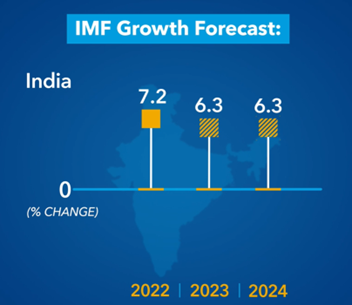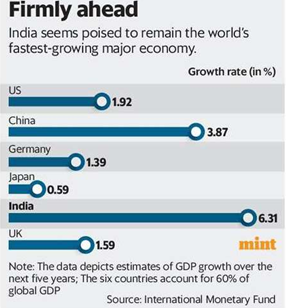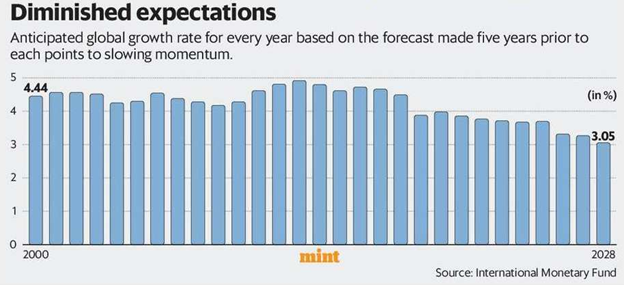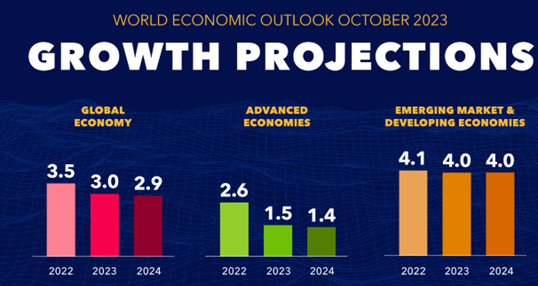India’s economy offers global hope
Relevance
- GS Paper 3 Indian Economy and issues relating to Planning, Mobilization of Resources, Growth, Development and Employment.
- Tags: #IMFforecasts #IndianEconomy #MintEditorial #UPSCMains2024.
Why in the News?
The recent International Monetary Fund (IMF) World Economic Outlook suggests a global economic slowdown, but India stands out as a potential exception with the potential to accelerate growth, given the right strategies.
Global Economy Slows, India Shines
- The IMF, Multilateral lender, provides updates twice a year.
- Conditions seem a little uncertain in the recent World Economic Outlook.
- The predictions for the next five years till 2028 reveal that most countries are slowing down economically.
- But there’s a bright spot “India”, if these predictions hold true, India could be the fastest-growing big economy for 11 out of 15 years since 2014, as noted by Roshan Kishore in the Hindustan Times.
- This means India is standing out in a world of economic slowdowns.
Global Growth Outlook Declines
- In a chart depicting global momentum loss, the IMF’s forecasts from five years prior reveal a concerning trend.
- The forecasted growth rate for 2028 is the lowest since 1990, indicating a global economic slowdown.
- This downward trend is worrisome, especially since it started before the North Atlantic financial crisis in 2008.
Persistent Economic Forecasting Errors
- The IMF acknowledges that its economic forecasts have consistently been too optimistic.
- This means that actual global growth has often fallen short of their predictions made five years earlier.
- The majority predictions from economists in the private sector have followed this pattern.
- As a result, the gradual global economic slowdown that began after the financial crisis is unlikely to reverse in the current decade, posing long-term challenges for the world economy.
India’s Long-Term Growth Strategy
- Prime Minister Narendra Modi plans to reveal a new economic strategy in December, outlining India’s path to becoming a developed country by 2047.
- The strategy, developed by Niti Aayog in collaboration with government officials, comes at a crucial time when global economic challenges persist.
- It reflects India’s commitment to long-term growth and development.
India’s Growth Challenge for Developed Status
- Economists at the Reserve Bank of India state that India must achieve a 7.6% annual growth rate for it to become a developed nation by 2047.
- This target exceeds what many experts believe India can sustain without causing high inflation or straining international payments.
- This highlights the need for ambitious economic reforms and policies to maintain a higher growth trajectory while avoiding adverse economic consequences.
Global Economic Slowdown’s Impact on India
- The global economic slowdown predicted by the IMF over the next five years could pose a challenge for India.
- While it may not halt India’s average growth rate seen in recent decades, it could hinder any significant acceleration.
- India must navigate not only a slower world economy but also challenges like increasing protectionism due to geopolitics and climate change shocks.
- Balancing these factors will be vital for India’s sustained economic progress.
India’s Growth Advantage, but Caution Required
- India’s current growth pace is enough to secure its position as the fastest-growing major economy.
- However, it’s crucial to note that neighboring economies in the east were growing significantly faster at similar development stages.
- So, while India’s growth is impressive, there’s room for improvement to catch up with some of the remarkable growth stories in the region.
Global Economic Growth Contributors
-
- From 2023 to 2028, the global economy is set to expand by $29 trillion.
- The US and China, the world’s largest economies, will each contribute $5.9 trillion, roughly 20% of the total growth.
- India, however, will add $2.2 trillion, securing its position as the third-largest contributor to global economic growth.
- This highlights India’s significant role in shaping the world’s economic future.
Unlocking India’s Path to Accelerated Growth
In a comprehensive analysis by Barclays economists, they suggest that
- India has the potential to boost its growth rate after the 2024 elections without jeopardizing its hard-earned economic stability.
To reach an impressive 8% growth trajectory, several critical factors need addressing:
- Increased Nominal Savings: Elevating savings from 2% to 32.3% of GDP could provide a financial foundation for growth.
- Growing Workforce: Encouraging higher female labor force participation and expanding the workforce at 5% annually (versus the current 1%) can stimulate economic expansion.
- Global Exports Expansion: Raising India’s global export share from 2.4% to over 4.5% can strengthen the country’s economic position on the world stage.
- Productivity Enhancement: Improving capital efficiency by reducing the current incremental capital-output ratio of 5 can boost overall productivity.
Geopolitical Advantage: India vs. China
- Barclays economists suggest that if India can maintain an 8% growth rate, it could surpass China in its contribution to global economic growth.
- This reaffirms the idea that such robust growth serves as India’s best foreign policy.
Despite global challenges, India is expected to stand out as a promising growth destination. Drawing from the examples of certain Asian countries during the challenging 1970s, India can accelerate its growth by focusing on key elements: increasing savings, optimizing capital usage, boosting workforce participation, particularly among women, and expanding exports alongside domestic demand. These building blocks can elevate India’s sustainable economic growth rate in a tough global environment.
|
What is the IMF?
Foundation of the IMF
IMF’s Key Missions The IMF has 3 crucial missions
IMF’s Functions
IMF’s Response to COVID-19
|
Source: Livemint
Mains Question
Discuss the findings and implications of the recent International Monetary Fund (IMF) World Economic Outlook for global economic growth. How the global economic slowdown, as projected by the IMF, can impact India’s economic growth?







